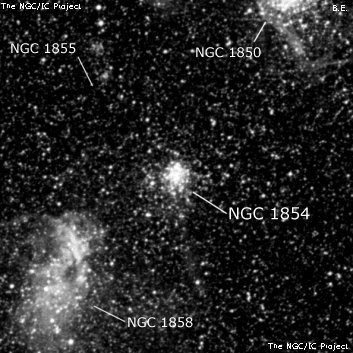
John Herschel discovered NGC 1855 = h2783 on 2 Nov 1834 and described "a vB, L, round cluster of stars 12m, 5' diameter [N.B. this obs must refer to the general cluster in which the former (h2782 = NGC 1854) is situated as a nebulous-looking knot - a combination of the most ordinary occurence in the Nubecula Major, though very rare in other parts of the heavens]." He has 5 observations of h2782 (the central core of the cluster), but only this single observation noting a much larger field. Most sources, such as ESO and SIMBAD, simply equate the two numbers or refer to the cluster as NGC 1855, though Brent Archinal has separate listings for both objects in his book "Star Clusters".
James Dunlop probably discovered NGC 1854 = D 119 (the core of the cluster) on 2 Aug 1826 and described a "small round pretty well-defined nebula". His position is 12' ESE of NGC 1855, a typical error shared by D 120 = NGC 1858. Dunlop is not credited in JH's catalogues or the NGC.
400/500mm - 18" (7/10/05 - Magellan Observatory, Australia): see description for NGC 1854.
600/800mm - 24" (4/7/08 - Magellan Observatory, Australia): at 350, the cluster was resolved into numerous faint stars around the edges of the intense core. Up to a couple of dozen very faint stars popped in and out of visibility. The core (NGC 1854) is noticeably elongated N-S and is surrounded by a large, much fainter halo (NGC 1855).
Notes by Steve Gottlieb